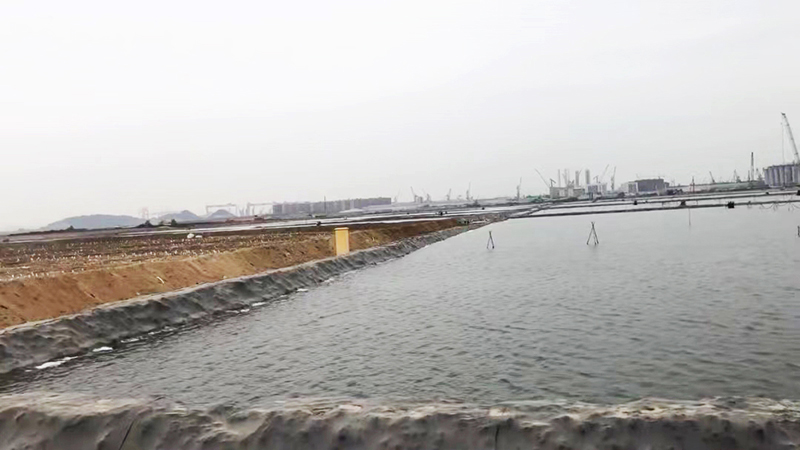Key points of construction technology for vacuum preloading reinforcement of soft soil foundation
The basic principle of vacuum preloading method for strengthening soft soil foundation
The vacuum preloading method is to lay reinforcement materials on the surface of the reinforced soft soil, install plastic drainage boards, bury vertical drainage pipes, use sealing membranes to make the laid reinforcement layer in a vacuum state, and then carry out buried pressure treatment. By using suction pipelines and vacuum pumps, the soft foundation and reinforcement layer achieve negative pressure under the membrane, achieving the effect of soil drainage consolidation and strength enhancement. Because the total stress of the soil is variable, the applied atmospheric load generates an excess static pore water pressure stress in the soil, which is discharged through the pore water in the pores. The soil is compacted, and the effective stress of the soft soil increases.


In general, the vacuum preloading method involves constructing clay curtain walls around the area to be treated, forming a closed area. Plastic drainage boards are evenly inserted into the soft clay, covered with a layer of sand, and then covered with a layer of geotextile. Two layers of sealing films are placed on top to seal the area. The clay forms a closed space for the curtain wall and sealing film, and the drainage belt and sand layer inside the film are partially vacuum by vacuum rod pumping, to remove moisture from the soil, A foundation treatment method that consolidates soil in advance to reduce foundation settlement. The main principles are reflected in three aspects: firstly, there is a difference in the internal and external loads of the film; secondly, the effect of groundwater level on additional stress; and thirdly, the discharge of water and gas causes the soil to solidify.
The vacuum preloading method for treating soft soil foundation is a systematic project that requires the development of standardized construction processes, the preparation of a complete construction organization plan, ensuring that the project quality is not reworked, controlling project costs reasonably, and ensuring quality.
(1) Make good preparations for construction, design, review, and review construction drawings, ensure that construction personnel accurately understand the relevant requirements and technical parameters of the design drawings, provide safety technical disclosure, and ensure standardized construction. Conduct a thorough inspection of the laying materials, including the mud content and water permeability of the sand and gravel, to ensure the quality of the sand and gravel before laying. Check whether the sealing film meets the standards in terms of sealing, thickness, and material. Strictly adhere to the supplier qualification of the sealing film, purchase through formal channels, and conduct quality sampling for plastic drainage boards and vacuum pipe networks to ensure that they meet the design requirements in terms of material and size, ensuring qualified quality. Inspect and debug the mechanical equipment related to vacuum preloading, and adjust it to appropriate parameters and optimal performance according to the engineering preloading requirements. Construction can only proceed after the preparation work is ready.
(2) Do a good job in surface treatment of soft soil foundation, and backfill soft soil that cannot be mechanically used. Reinforcement measures such as laying fences and geotextiles can be used. The backfill material should not be mixed with large stones to prevent the drainage board from being unable to insert.
(3) Construction of clay sealing walls around the processing area requires testing before construction to ensure that the clay is a qualified sealing wall.
(4) Do a good job in the construction of the lower layer of sand cushion, bury drainage boards and relevant equipment for testing groundwater level and compaction at the specified thickness and position, and then proceed with the construction of the middle layer of sand cushion. After the completion of the vacuum network, sealing ditch construction, backfilling, and other processes, lay pre inspected sealing films, install vacuum pumping equipment, conduct trial vacuum pumping, and finally lay the upper layer of geotextile and sand cushion to officially extract vacuum, End the operation after passing the inspection. During this process, it is necessary to ensure that the construction is carried out according to the steps.
Technical points
(1) The sealing wall must be qualified and the quality must be strictly controlled, otherwise the sealing wall will leak and the vacuum pumping effect will not be achieved.
(2) The construction technology of drainage boards requires the use of anti clogging and depth measuring drainage boards. The construction of drainage boards must ensure depth and not penetrate impermeable layers. In particularly weak geological conditions, especially muddy geology, the end treatment technology of drainage boards should be adopted to ensure that the inserted drainage boards are not carried out.
(3) Sealing film laying technology: Before laying the sealing film, it is necessary to clean the sand cushion layer to prevent affecting the use of the sealing film. During the laying process of the sealing film, its tightness should be controlled. The two layers of sealing film should be laid layer by layer to maintain the integrity of the sealing film. During the on-site pasting process, it should be carried out from top to bottom along the adhesive seam, and can only be used after the adhesion meets the requirements.
In recent years, with the increasingly mature technology of vacuum preloading, it has been widely applied in modern engineering construction, and the engineering geological environment involved has become increasingly complex. Especially in engineering projects such as land reclamation, port construction, docks, and airport plot renovation, soft foundation treatment is particularly important. Using vacuum preloading to reinforce soft foundation has the advantages of not damaging the environment, low cost The technology of vacuum preloading for soft foundation treatment has been widely used due to its advantages such as low construction difficulty.

